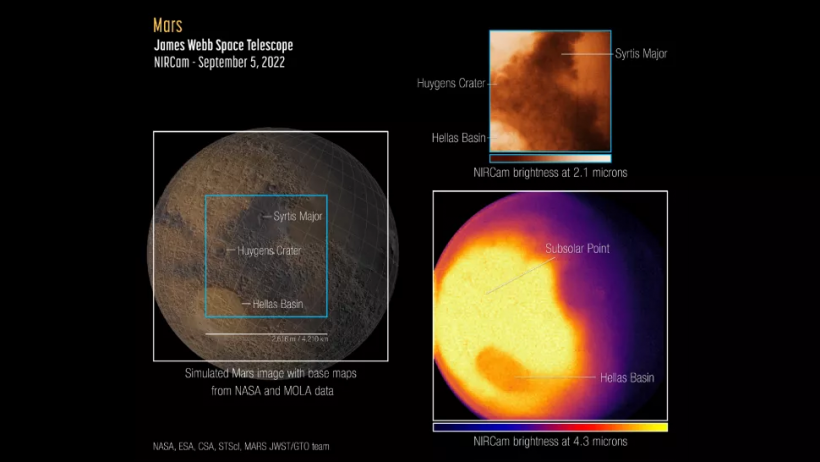(EPSC) NASA's James Webb Space Telescope (JWST) has captured its first-ever images of the Red Planet, viewing infrared light from Mars with high sensitivity.
The known James Webb Space Telescope's first images and spectra of the planet were revealed on Sept. 19, Monday, at the Europlanet Science Congress (EPSC).
The world's most powerful telescope can transient occurrences on Mars, like weather patterns and dust storms.
The images and measurements were made on Sept. 5 from JWST's location, around 1.6 million kilometers (a million miles) from Mars.
Mars' images of the observable disk- the portion of the planet being lit by the sun and facing the telescope- were captured by JWST's Near-Infrared Camera (NIRCam) and can provide planetary scientists with a different view of Mars.
The data was delivered with the help of rovers such as NASA's Perseverance and a craft in Mars' orbit.
Since the Red Planet is bright and close, it wasn't easy for the Webb's to visualize.
During the ESPC press conference, the lead investigator and Goddard Space Flight Center Scientist Giuliano Liuzzi said that Mars' brightness became a challenge for them to see planet.
Mars' Blinding Brightness
The research scientists used ample exposure to prevent the infrared light from the Red Planet from blinding JWST's equipment.
Meaning they measured some light that reached JWST's detector and applied different ways to examine the gathered data.
With spatial resolution, the JWST could capture the needed images and spectra. Astronomers then will analyze the short-term occurrences on the planet, such as dust storms, Martian weather patterns, and the changes caused by the seasons.
Adding to the Webb telescope's might, it can also capture events that occur at different times throughout the Martian day in a single observation.
Mars' first infrared images show a region in the eastern hemisphere in two different light wavelengths.
The image with a short wavelength is dominated by sunlight's reflection and presents Mars' surface that resembles features seen in visible light. It includes a near 280-mile-wide crater and a dark volcanic rock at the Syrtis Major Planum.
Based on NASA's report, Webb's telescope NIRCam caught the light that the planet emits in a longer wavelength as it loses humidity. The said brightness correlates to the planet's atmosphere and temperature. It decreases towards the Martian polar areas that are exposed to lesser sunlight.

The James Webb Space Telescope's first images of Mars were captured by its NIRCam instrument on Sept. 5, 2022
Hella Basin's Atmospheric Hints
Analyzing the light spectrum of detected light from the planet can help astronomers to know the components of Mars' surface and atmosphere.
Luizzi and his team found a 1,200-mile-wide Hellas Basin darker than its surroundings, even during the hottest time of the planet's day.
Luizzi said, "One of the neat things is that [you] can see a dark patch that is a basin on Mars."
Luizzi added that the structure results from light passing through Mars' atmosphere and being absorbed by CO2.
"The Hellas Basin is lower altitude, and thus experiences higher air pressure," according to the Goddard researchers. When the pressure gets higher, it suppresses thermal emission in a particular wavelength called pressure broadening.
The images will also show the ability of JWST to study Mars in a technique called spectroscopy on measurements taken using the Near-Infrared Spectrograph instrument.
JWST Observations will recognize the water presence, C02, carbon monoxide, and other chemical components.
Luizzi also mentioned the inclusion of methane observation, stating its importance in describing Mars's geological processes.
NASA's JWST team is producing a paper showing its findings for review.
RELATED ARTICLE: NASA James Webb Space Telescope Leaks Secret Photos of Jupiter [LOOK]
Check out more news and information on Space in Science Times.














